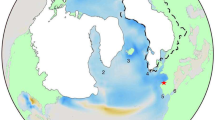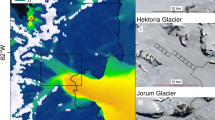Abstract
MELT layers in ice cores are formed by melting on the snow-pack surface, which produces water that percolates down and refreezes in the colder snow layers below. Melt layers are distinguished by their 'bubble' texture. Because more ice forms in the snow pack in warm summers than in cool summers, the changing concentration with depth of melt layers in snow pits1,2 and ice cores3–5 is an indicator of past summer climate. Here we report on studies of melt layers in two Canadian high-Arctic surface-to-bedrock ice cores. Although changes in elevation of the drill site owing to isostatic depression and uplift may contribute up to 40% of the total climatic signal recorded in the melt layers, we interpret their varying concentrations in terms of changing summer temperatures over the past 10,000 years. The warmest summers occurred 8–10 kyr ago and the coldest only 150 years ago. The summers over the past 100 years have been the warmest for more than 1,000 years, but are still not as warm as those of the early Holocene. The melt-layer record is in broad agreement with geological records of glacier retreat during the Holocene6–8, indicating that these data also contain information of regional significance.
This is a preview of subscription content, access via your institution
Access options
Subscribe to this journal
Receive 51 print issues and online access
$199.00 per year
only $3.90 per issue
Buy this article
- Purchase on Springer Link
- Instant access to full article PDF
Prices may be subject to local taxes which are calculated during checkout
Similar content being viewed by others
References
Ahlmann, H. W. Glaciological Research on the North Atlantic Coasts, R. geogr. Soc. Res. Ser. No. 1 (London, 1948).
Hattersley-Smith, G. Geogr. Annlr 45, 139–141 (1963).
Koerner, R. M. Science 196, 15–18 (1977).
Herron, M. M., Herron, S. L. & Langway, C. C. Nature 293, 389–391 (1981).
Hibler, W. D. & Langway, C. C. in Polar Oceans (ed. Dunbar, M. J.) 589–602, (Arctic Inst. N. Am. Montreal, 1977).
Bednarski, J. Can. J. Earth Sci. 23, 1343–1355 (1986).
Lemmen, D. S. Can. J. Earth Sci. (in the press).
Blake, W. S. Jr Geogr. Annlr A 57, 1–71 (1975).
Fisher, D. A. et al. Nature 301, 205–209 (1983).
Koerner, R. M., Fisher, D. A. & Paterson, W. S. B. Can. J. Earth Sci. 24, 296–301 (1987).
Fisher, D. A. & Koerner, R. M. J. Glaciol. 32, 501–510 (1986).
Koerner, R. M. Science 244, 964–968 (1989).
Robin, G. de Q. & Johnsen, S. J. in The Climatic Record in Polar Ice Sheets (ed. Robin, G. de Q.) 47–52 (Cambridge University Press, 1983).
Raisbeck, G. M. et al. Nature 326, 273–277 (1987).
Herron, M. M. & Langway, C. C. Jr in Greenland Ice Core: Geophysics, Geochemistry, and the Environment (eds Langway, C. C., Oeschger, H. & Dansgaard, W.) 77–84 (Am. Geophys. Un., Washington, DC, 1985).
Clausen, H. B. et al. Ann. Glaciol. 10, 10–15 (1988).
Paterson, W. S. B. & Waddington, E. D. Rev. Geophys. Space Phys. 22, 123–130 (1984).
Koerner, R. M. J. Glaciol. 22, 25–41 (1979).
England, J. Quat. Res. 9, 185–202 (1976).
Blake, W. Radiocarbon Dates Vols. 26, 34 (Geol. Surv. Can. Ottawa, 1987).
Dansgaard, W., Johnsen, S. J., Clausen, H. B. & Gundestrup, N. Meddelelser Om Gronland Bd 197, Nr. 2, 1–53 (Reitzels. Copenhagen, 1973).
Fisher, D. A. & Koerner, R. M. in Climatic Change in Canada Vol. 3 (ed. Harington, C. R.) 50–69 (Natn. Mus. Nat. Sci., Ottawa, 1983).
Kelly, M. Geol. Surv. Greenland Rep. No. 96, (1980).
Hattersley-Smith, G. in Climatic Changes in Arctic Areas During the Last Ten Thousand Years (eds Vasari, Y., Hyvarinen, H. & Hicks, S.) 137–148 (Oulu University, Finland, 1972).
Muller, F. in Proc. Symp. Arctic Heat Budget Atmospheric Circulation (ed. Fletcher, J. O.) 136–156 (Rand Corp., Santa Monica, 1966).
England, J. Can. J. Earth Sci. 20, 895–917 (1983).
Havens, J. Meteorology, Res. Rep. No. 2 (McGill University, Montreal 1964).
Paterson, W. S. B. The Physics of Glaciers (Pergamon, Oxford, 1981).
Kutzbach, J. E. in The Geology of North America Vol. K-3 (eds Ruddiman, W. F. & Wright, H. E. Jr) 425–446 (Geol. Soc. Am., Boulder, 1987).
Hammer, C. U. et al. J. Glaciol. 20, 3–26 (1978).
Hammer, C. U. Jökull 34, 51–65 (1984).
Hammer, C. U., Clausen, H. B. & Tauber, H. Radiocarbon 28, 284–291 (1986).
Author information
Authors and Affiliations
Rights and permissions
About this article
Cite this article
Koerner, R., Fisher, D. A record of Holocene summer climate from a Canadian high-Arctic ice core. Nature 343, 630–631 (1990). https://doi.org/10.1038/343630a0
Received:
Accepted:
Issue Date:
DOI: https://doi.org/10.1038/343630a0
This article is cited by
-
Holocene vegetation and hydrology variations and their associations with climate changes: a multi-proxy analysis of a sediment core from an alpine basin in the middle Tianshan Mountains
Climate Dynamics (2021)
-
Amplification of the Atlantic Multidecadal Oscillation associated with the onset of the industrial-era warming
Scientific Reports (2017)
-
The Arctic freshwater cycle during a naturally and an anthropogenically induced warm climate
Climate Dynamics (2014)
-
Holocene thinning of the Greenland ice sheet
Nature (2009)
-
Sedimentary pellets as an ice-cover proxy in a High Arctic ice-covered lake
Journal of Paleolimnology (2009)
Comments
By submitting a comment you agree to abide by our Terms and Community Guidelines. If you find something abusive or that does not comply with our terms or guidelines please flag it as inappropriate.



